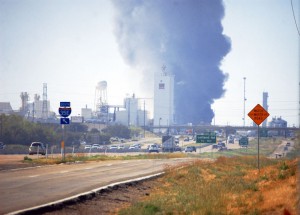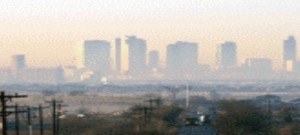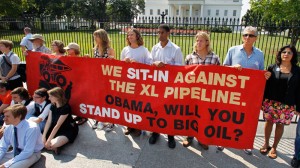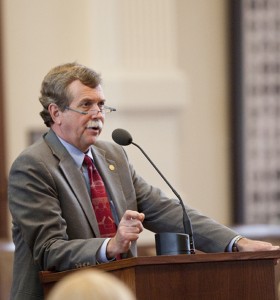Waxahachie’s Magnablend Settles Lawsuit with Injured Employee
 Once you read the damning testimony of Magnablend's own employees in the Waxahachie Daily Light coverage of the trial, you only wondered how long it would take for the company to settle with James Barron, who claimed the October 3rd explosion and fire at the chemical blending facility had resulted in permanent neurological damage.
Once you read the damning testimony of Magnablend's own employees in the Waxahachie Daily Light coverage of the trial, you only wondered how long it would take for the company to settle with James Barron, who claimed the October 3rd explosion and fire at the chemical blending facility had resulted in permanent neurological damage.
The answer was: one week.
There was one important footnote to pause and ponder. If one reads between the lines of testimony, the implication is the company's new expansion into supplying the fracking industry's chemical needs was behind the 2011 accident, which sent smoke wafting all the way into downtown Dallas.
In cross-examination of company supervisors, it came out that despite Magnablend beginning to manufacture "new blends of chemicals" it was unfamiliar with, the company's on-site chemist wasn't reading the product information that came with the new chemicals. Ventilation in the facility might have been adequate for the kind of chemicals it had historically blended, but it was unable to cope with the build-up of hydrogen that formed when the new batch of chemicals were blended. It's that hydrogen cloud that caused the explosion and fire.
So is Magnablend still blending chemicals for the fracking industry? Is there still a potential for the same kind of accident to occur? if they aren't doing this kind of blending anymore, who is? What facilities are dealing with the same chemicals Magnablend was mixing, and where are they located? Nobody had ever heard of Magnablend before it blew up. Is there another heretofore unknown manufacturer who's taking the same risks without their neighbors knowing it? You can count on it.
Terms of the settlement with Barron were not made public. Magnablend still faces 21 other civil cases arising from the 2011 accident.
FracFocus Fail
 Remember how the gas and oil industry was going to police itself by voluntarily disclosing all those nasty chemicals they put in "fracking fluids" in one easy-to-access-online database? Frac Focus was the 21st Century template for a new level of government-industry cooperation, hailed by Reasonable People everywhere as the answer to getting the truth about what chemicals were really being injected and regurgitated during a frack job. Finally, there would be much needed industry transparency.
Remember how the gas and oil industry was going to police itself by voluntarily disclosing all those nasty chemicals they put in "fracking fluids" in one easy-to-access-online database? Frac Focus was the 21st Century template for a new level of government-industry cooperation, hailed by Reasonable People everywhere as the answer to getting the truth about what chemicals were really being injected and regurgitated during a frack job. Finally, there would be much needed industry transparency.
Turns out. Not so much.
"Oil companies are shielding too much information from public view in an industry-backed database for disclosing chemicals used in oil and gas wells, engineers, environmentalists and energy experts told the Obama administration on Thursday.
The FracFocus registry also contains errors that undermine its role as the leading mechanism for tracking hydraulic fracturing chemicals used in unconventional oil and gas production, said an Energy Department advisory board."
This was no tree-huggers' group making that criticism. It's an advisory board that includes Texas A&M University’s Stephen Holditch, Ram Shenoy with ConocoPhillips, and former Assistant Secretary of Energy Susan Tierney.
As predicted by citizens, the major problem is that companies still want to hide behind the "trade secrets" exemptions and not fully disclose what's in the witches' brew of chemicals they're using.
According to the advisory board, 84 percent of the wells registered in FracFocus invoked a trade secret exemption for at least one chemical since June 1, 2013. In Texas alone, 5,509 of the 6,406 disclosures made in the same time frame invoked a trade secret exception.
So much for transparency. This is exactly why municipalities and states must insist on real full disclosure in their own local ordinances and laws instead of relying on an industry-financed website.
D-I-V-O-R-C-E….Is the Frisco-Exide Settlement On the Rocks?
 After a brief honeymoon, is it Splitsville for the 2012 clean-up agreement between Exide and the City of Frisco? And if their shotgun marriage is breaking apart, what are the implications for Frisco residents and the surrounding area, including Lake Lewisville, a source of drinking water for Dallas that sits directly downstream of what now may become a Superfund site?
After a brief honeymoon, is it Splitsville for the 2012 clean-up agreement between Exide and the City of Frisco? And if their shotgun marriage is breaking apart, what are the implications for Frisco residents and the surrounding area, including Lake Lewisville, a source of drinking water for Dallas that sits directly downstream of what now may become a Superfund site?
On February 25th, Channel 11 broke the story that, after almost two years of assuming the settlement would guide clean-up efforts, the City of Frisco doesn't "know if the company will stick with the deal or walk away from it until the company files a reorganization plan by the end of May."
That's a big deal. Having declared bankruptcy last year, Exide is now dealing with thousands of creditors with competing claims. Frisco is only one of them, and only one of a half dozen closed or operating lead smelter sites that are also suffering from contamination. If the City's deal with the company can't survive the bankruptcy process, all the current planning for clean-up and redevelopment of the outer ring of Exide will be derailed. And that's important because the settlement has been the Frisco City Council's justification for not opening up the fate of the property to more public discussion, like whether residents would prefer building a toxic landfill and keeping Exide's waste in town, or cleaning up the entire sire and hauling off all contamination to allow for normal development.
It's also important because without the city's deal in place, and Exide in bankruptcy court, there is no Plan B to prevent the entire site from becoming an EPA federal Superfund site, exactly the same way the still languishing RSR lead smelter site in West Dallas ended up as as Superfund site in the early 1990's after that company went belly up. It's a designation that Frisco officials are known to dread.
There have been signs of trouble with the agreement for months now. According to documents filed by the City of Frisco in federal bankruptcy court last December, Exide is in default on its agreement with the City, and risks further claims of breaches, as well as “fraud in the negotiation, execution, and performance” of the settlement.
The historic 2012 settlement arranged for a swap of 179 acres of Exide-owned land in Frisco in return for $45 million from the Frisco Economic Development Corporation and the Frisco Community Development Corporation. Passed unanimously by the Frisco City Council with only a week’s public notice and no public hearings, the agreement closed the smelter earlier than expected but is based on an elaborate series of conditions and clean-up standards.
It’s at least one of those conditions, the required demolition of “all above-ground structures” in a section of the smelter site the city is purchasing called the “Bowtie Parcel,” which appears to be the center of the default claim by Frisco. Specifically, it’s the continued presence of a specialized building involved in the treatment of the smelter’s wastewater known as “The Crystallizer,” that prompted the legal tension.
Last August, Mack Borchardt, the City’s Special Assistant in charge of monitoring the Exide clean-up, wrote a letter to the company disputing the Agreement’s demolition provision had been fulfilled as long as the Crystallizer remained standing:
“Frisco disagrees with your assessment that the demolition activities on the Bowtie Property have been completed and demand that you retract Exide’s notice immediately. For example, the Master Settlement Agreement requires (A)ll above ground facilities on the Bowtie Parcel…” to be removed from the Bowtie Parcel as part of Demolition Activities.” The above ground facilities include the Crystallizer which has not been removed and it has not been approved in writing by Frisco to remain standing. If you fail to immediately withdraw Exide’s notice, Frisco reserves the right to pursue all available remedies.”
By December 9th, when a Bankruptcy Court deadline required the City to file its claims against Exide, Frisco City Hall was adamant that “Exide has not demolished and removed all above ground facilities…. As a result, Exide is in default on its performance obligations under the Master Settlement Agreement.” But along with that outstanding claim, City lawyers also added a new list of possible Exide violations, both civil and criminal:
“Finally, Frisco may also have additional contract and/or tort based claims against Exide, including,without limitation, breaches of the Master Settlement Agreement, nuisance, quantum meruit, money had and received, breach of fiduciary duty, negligence and gross negligence, conspiracy, and claims based on fraud and fraud in the inducement and/or negligent misrepresentations relating to the negotiation, execution, and performance of the Master Settlement Agreement.”
If the deal between Frisco and Exide comes apart, there’s nothing to guarantee that any of the smelter property gets cleaned-up or redeveloped the way the City’s been promising.
Although the entire Exide smelter site and surrounding property is full of toxic hot spots, the facility at the center of the latest legal dispute, “the Crystallizer,” has been a source of particular regulatory concern. As part of the final processing of contaminated waste water at the smelter, it condensed filtered liquids into sodium sulfate solids.
In a December 2009 report, EPA inspectors at Exide observed, “Uncontrolled salt laden runoff from the Crystallizer plant was observed as salt deposition on the concrete aprons around this process area at the plant. The ‘frac’ tank used for holding purge water from the crystallizer plant was leaking at the time of viewing.” This crystallized substance tested high for toxic metals content and testing of the contents of the frac tank showed toxic levels of selenium and cadmium.
In September 2010 inspectors again found “uncontrolled salt laden runoff from the Crystallizer plant and also that the frac tank was leaking.”
In July of last year the Texas Commission on Environmental Quality reported that “the levels of sulfate in soils surrounding the Crystallizer unit are much higher than in other areas” and “drums of PCBs were noted in the Crystallizer area.” PCBs, or Polychlorinated biphenyls, were once widely used as cooling fluids, but have been banned in the US since 1979 because of their persistent toxicity.
Because of its use of chlorine in treatment of waste, the Crystallizer could also be one of the major reasons Exide became one of Texas’ largest Dioxin polluters. In 2009, the Frisco facility was ranked as the 9th largest source for Dioxin pollution in Texas, surpassing all other North Texas facilities, including the Midlothian cement plants. Dioxin is one of the most potent toxins ever tested by EPA, and is measured in grams, not pounds.
Despite this history, no testing for Dioxin contamination has ever taken place at the former Exide smelter site by any regulatory agency, and that’s a point of contention for critics of the smelter clean-up.
Exide’s choice to risk an agreement that could give it $45 million in much-needed cash over the demolition of one remaining structure is curious. And it’s one that poses a challenge to the entire future the City of Frisco has laid out for the smelter site. If the City doesn’t buy the 179 acres of Exide property surrounding the smelter, it’s fate will be tied to the company’s and it might either become part of a future Superfund site or languish in a kind of real estate purgatory for a very long time.
That would more than double the size of the economic black hole the core plant site already poses for central Frisco. Frisco City Hall has come out in favor of locating a permanent toxic dump for Exide waste on that core property, but residents who are members of the local group Frisco Unleaded says there’s no reason to believe an Exide landfill would be run any better than an Exide smelter.
There's already been documentation of extensive lead contamination up and down Stewart Creek from the Exide property, through Grand Park and all the way to Lake Lewisville. Although the City of Dallas Water Utilities Department says that's not a threat to the city's drinking water because of its treatment facilities, the presence of a large landfill and/or Superfund site poses a danger of catastrophic releases that an operating smelter doesn't. And of course, recreational users of the Lake are being routinely exposed.
On February 26th, the Dallas Morning News identified competing plans for the clean-up of Stewart Creek as another source of tension between Frisco and Exide.
The only good news from this great unraveling is that it provides a chance to restart the public debate about what to do with the Exide site – a debate that was short-circuited by the council's settlement agreement that made everything seem like a done deal, even though its obvious now there were a lot of unanswered questions. There continues to be a need for a bottom-up, community wide discussion of what Frisco residents want to see happen with the site. Events in May might make that a more pressing priority.
Lon Burnam: Fighting the Good Fights That Needed Fighting In Austin for 18 Years
Among all the election news from yesterday's primary results, the most depressing, and potentially most devastating, is the loss of 18-year incumbent State Representative Lon Burnam from Fort Worth.
It's a terrible blow not because Lon provided the margin of victory on close environmental votes in Austin. There haven't been any of those in the Texas House of Representatives in over a decade. It's not because he occupied positions of power. Representing an intensely urban area, for years he was exiled by the House leadership – both Democratic and Republican – to outposts like the House Agriculture Committee as punishment for his progressive views.
No, the pain from this loss will last because Lon Burnam was one of us, an activist, an organizer. Maybe the last one of us to serve in the Texas House for quite a while.
Lon grew up in Cowtown with middle-class parents who were dedicated environmentalists and community activists themselves – right into their 90's. He spent his boyhood camping with his family and watching his mother and father both participate heavily in the civic life of his hometown. He absorbed their examples fast. He was a political progeny.
Lon worked in campaigns for candidates for elected office from before he could vote. Even though he was very young, every leading liberal Democrat, not just in Tarrant County but throughout the state, knew about his contributions and sought his energy for their own cause.
Not long after graduating from UTA with an Urban Planning (not law) degree, Lon and two other Fort Worth natives founded the first anti-nuclear group in Texas in 1977 to try and stop the Comanche Peak nuclear power plant. Like so many fights Lon would take up, it was a good one, one worth fighting for years to come, but one with the odds stacked heavily against him.
He was an organizer for Clean Water Action in the mid-1990's, helping Downwinders fight against the burning of hazardous waste in the Midlothian cement plants and working on anti-smog issues. For years he was the Director of the Dallas Peace Center. How many people even know that JR's hometown has a Peace Center? Much less understand what it took to run it on either side of 9/11? But his real ambition was to be a legislator. Despite his peers forsaking office-holding for community organizing or other kinds of advocacy, Lon held the quaint view that public service should actually be that, and was its own best kind of advocacy work. He ran twice and lost before finally winning a seat in the Texas House of Representatives in 1996.
Once elected, his views didn't change. It was still all about fighting the good fight, no matter the odds. Whether it was same-sex marriage, immigration, nuclear waste, insurance reform, fracking, or anything remotely progressive, Lon was the elected official you could count on to take up for your cause and fight for it. Not for nothing is there a framed picture on his office wall showing him casting the lone vote against a House resolution supporting the Iraq war in 2003.
That was the official support he gave. But as important was the unofficial support he and his office offered to "constituents" who lived outside his district, but served his district's cause. If you were a clean air activist who needed a place to use as base camp while you were in Austin, you were always welcomed at Lon's. He made his staff available for work in the field with you, as well as in the office for you. Instead of trying to wrestle a state agency to the ground for months to get some documents, Lon would write an official request and get them for you in weeks. When you couldn't get an official to return a call, Lon would get the drawbridge lowered. He knew that his title could get him through doors the rest of us had trouble opening – because you see, he had been one of us and those doors had been closed to him at one point as well.
Lon's office in Austin provided one of the few oasises in a place that's increasingly hostile to regular folks. He used his staff to promote not only legislation but the issues driving the legislation. He used his position as a Bully Pulpit to draw attention to issues that otherwise wouldn't have received any. In other words, he did everything a community organizer would do if they held elected office. Even among our other Austin allies, this is what made Lon different, special, and beloved. And impossible to replace.
He lost yesterday to an opponent who's the logical end product of 21st Century Texas political cynicism. Beginning with Tom Delay's plan of a decade ago, Republicans have gerrymandered districts so severely in Texas cities that the only "safe" Democratic districts are also drawn as "minority" districts. The GOP wants only black and brown faces to represent the Democratic Party. In Lon's case, his district kept getting redrawn as a Hispanic district, with a higher and higher percentage of Hispanic vs Anglo or Black voters. And indeed, the challenger who won Tuesday's Democratic primary has a Hispanic surname. And that's it. He holds no progressive views on anything, has never fought hard for anything, doesn't really believe in anything but his own ambition.
It's one thing to be beaten by a legitimate progressive Hispanic candidate, quite another to be beaten by a cipher with a vowel on the end of his last name. It's this ethnically appropriate empty-suit aspect to the defeat that makes it so sour.
Although his last election was close, Lon has served so long and become such a fixture that many of us took it for granted he would squeeze by this time as well. This hard lesson must not be forgotten by any of us doing this kind of work. Especially for the next 5 to 10 years, as things get a lot worse before they get any better. Next January, things won't be much different if Greg Abbott is sitting at the Governor's desk in the Capitol. But it'll make a big difference to a lot of good folks that they can't stop by Lon Burnam's office.
If you get a chance, please call or e-mail Lon's office and tell him how much you appreciate what he's done and tried to do, and how much he'll be missed:
Lon.Burnam@house.state.tx.us
(512) 463-0740 (Austin office)
(817) 924-1997 (Ft. Worth office)
Eagle Ford Follow-Up: Your Tax Dollars at Work
 There's not much of a local air planning process left in DFW. What remains is an irregularly-scheduled "technical committee meeting" that mostly involves the staff of Rick Perry's Texas Commission on Environmental Quality explaining how their new anti-smog plan will be successful without the addition of any new pollution controls. But after this explanation any members of the audience can ask questions about the presentation. And if they need to, they can ask follow-up questions. It's the only forum where citizens can do this with a real live TCEQ staffer and the staff is expected to respond. You may not like their response, but there is an exchange.
There's not much of a local air planning process left in DFW. What remains is an irregularly-scheduled "technical committee meeting" that mostly involves the staff of Rick Perry's Texas Commission on Environmental Quality explaining how their new anti-smog plan will be successful without the addition of any new pollution controls. But after this explanation any members of the audience can ask questions about the presentation. And if they need to, they can ask follow-up questions. It's the only forum where citizens can do this with a real live TCEQ staffer and the staff is expected to respond. You may not like their response, but there is an exchange.
The value of a place where citizens can ask questions of TCEQ and expect to get answers rises when one reads about how difficult it was for the reporters working on the huge Eagle Ford expose published last week to get anyone at the TCEQ to answer their questions at all, much less in person. In a sidebar piece that ran with the original piece, titled "How We Got the Eagle Ford Story," they explain the obstacles the state put in their way,
The agency responsible for regulating air emissions—the TCEQ—refused to make any of its commissioners, officials or investigators available for interviews. Instead, we had to submit questions via emails that were routed through agency spokespeople. It's unclear if the spokespeople passed our questions along to the agency’s experts. We received answers to most of our emails, often in some detail. But some of our questions were ignored or answered with talking points on general topics. The TCEQ employees who dealt with our public records requests were helpful and responsive, however. They discussed the filing process over the phone and answered questions about our requests.
*When a reporter called TCEQ field inspectors at their homes—a commonly used reporting technique—TCEQ spokeswoman Andrea Morrow left the reporter a message saying, “Under no circumstances are you to call our people and harass them at home.” Morrow also blocked the reporter from approaching the agency’s chairman, Bryan Shaw, at a public meeting in Austin.
The next DFW anti-smog plan "technical meeting" is 10 am on Thursday April 17th at the North Central Texas Council of Government's headquarters at 616 Six Flags Road in Arlington. One of the biggest controversies with the state's approach is determining the amount of gas and oil industry air pollution that's actually out there affecting DFW. The Eagle Ford story shines a bright spotlight on why the TCEQ really doesn't have a clue about the true amount of gas pollution, so why is it so confident about its numbers in the Barnett Shale, or the shale plays to the south and east of us that are upwind during "ozone season?" Good question. Come ask it on the 17th.
“Another Study Links Air Pollution to Autism” x4
 One of the areas of environmental health research that's producing almost monthly results is the varied and pernicious adverse human health effects of tiny particulate matter, or soot.
One of the areas of environmental health research that's producing almost monthly results is the varied and pernicious adverse human health effects of tiny particulate matter, or soot.
Once only blamed for respiratory problems and then heart attacks, it's now associated with a high blood pressure, strokes, immune system damage and a wide range of neurological diseases and conditions, including IQ loss, Parkinson's, and early dementia. That's because the particles are so small they pass through the lining of the lung and into a person's blood stream and can end up anywhere, including the brain.
Late last week saw the latest study to link PM pollution to autism. It was the fourth major study to do so in the last two years alone. But unlike the previous three, which found an epidemiological association between exposure to PM and the rate of autism in a community, this one may actually begin to explain the physiology of how PM attacks the brain:
"Researchers at the American Association for the Advancement of Sciences (AAAS) annual meeting in Chicago recently detailed the impact that constant exposure to air pollution may have on the developing brain. According to the panel, a series of mouse models have suggested that constant inhalation of air pollution may lead to enlargement of the brain’s ventricles – a hallmark of neurodevelopmental disorders such as schizophrenia and autism."
A brain's ventricular system is a set of four structures containing cerebrospinal fluid (CSF). It's continuous with the central canal of the spinal cord. Cerebrospinal fluid helps to protect the brain, keep it clean and boost its energy. When these ventricles are enlarged, it often indicates a damaged central nervous system. Dr. Deborah Cory-Slechta of the University of Rochester School of Medicine says that's what they found after exposing mice to PM pollution
“When the brain ventricles are too big, it pushes on the rest of the tissue,” Cory-Slectha said. “Also, you have these tracks of what’s called ‘white matter.’ And they cross over the brain; they connect the two hemispheres. And in these mice, those are either missing, or never developed, or died. We don’t know which, but a lot of that is missing, and that too is very characteristic of autism and schizophrenia.”
Ventriculomegaly – the enlargement of the ventricles – is also associated with a range of other brain diseases, such as bipolar disorder and Alzheimer’s disease, as well as a number of birth defects in children. Cory-Slectha noted that this brain damage was largely seen in the male rodents – an interesting finding given that both autism and schizophrenia are mainly male-oriented conditions.
“And part of that that is so interesting is both autism and schizophrenia, not only are they primarily in males, but the rates of those have been going up,” Cory-Slectha said. “And yet nobody can really ever explain why. [They say] it’s the diagnoses, etc. Well you know, air pollution has also gotten worse in some places, and you are exposed to it your entire life. So now we have the [epidemiological research] and we have the animal studies [to support that].”
She's right. We already have very strong correlations between levels of PM pollution and autism that this animal toxicology study now dovetails. Last June, the National Institute of Environmental Health Sciences published a study showing that women living in high air pollution areas while pregnant are up to twice as likely to have a child with autism as those living in less polluted areas.
In March of last year, researches at UCLA published a study showing the more Ozone and Particulate Matter pollution a baby in the womb is exposed to, the more likely he or she will be born with autism. It was the largest study of its kind to date.
In November of 2012, another UCLA study found that children who are born and live their first year closer to major freeways also suffer a significantly elevated risk of autism.
Scientists now know that there is no safe level of exposure to tiny PM pollution, called PM 2.5 because it's 2.5 microns or smaller. Any amount is capable of harming someone, especially if that someone is a child, senior citizen, or already ha health problems. And yet, regulatory agencies pretend this science doesn't exist – otherwise it would be very hard to issue permits for tons of new PM pollution, which they do almost every week.
There's been an explosion in the rate of autism in the US over the last 30 years. Could air pollution account for at least a sizable portion of that increase? The science is saying yes.
Eagle Ford Expose Reveals Weakness in Gas Air Pollution Inventories and That’s Bad News For DFW
 By now, many of you have seen the massive eight-month act of journalism that the Center for Public Integrity committed in describing the situation in the Eagle Ford shale play in South Texas. It's probably the most comprehensive look at what it's like to live in Texas fracking hell that's been published, and it rightly got distributed far and wide.
By now, many of you have seen the massive eight-month act of journalism that the Center for Public Integrity committed in describing the situation in the Eagle Ford shale play in South Texas. It's probably the most comprehensive look at what it's like to live in Texas fracking hell that's been published, and it rightly got distributed far and wide.
Along with the now-familiar litany of acute human health effects from gas mining – nosebleeds, headaches, skin rashes, respiratory problems – the article also talked about the smog-forming pollution cause by the thousands of small, medium-sized and large gas facilities that invade a shale play. Together they represent a formidable air quality challenge.
Centering on the Buehring family of Karnes City, the piece lists the inventory of gas mining infrastructure surrounding their home. Besides the 50 wells within two and a half miles, they also host,
"….at least nine oil and gas production facilities. Little is known about six of the facilities, because they don't have to file their emissions data with the state. Air permits or the remaining three sites show they house 25 compressor engines, 10 heater treaters, 6 flares, 4 glycol dehydrators and 65 storage tanks for oil, wastewater and condensate. Combined, those sites have the state's permission to release 189 tons of volatile organic compounds, a class of toxic chemicals that includes benzene and formaldehyde, into the air each year. That's about 12 percent more than Valero's Houston Oil Refinery disgorged in 2012.
Those three facilities also are allowed to release 142 tons of nitrogen oxides, 95 tons of carbon monoxide, 19 tons of sulfur dioxide, 8 tons of particulate matter and 0.31 tons of hydrogen sulfide per year. Sometimes the emissions soar high into the sky and are carried by the wind until they drop to the ground miles away. Sometimes they blow straight toward the Buehrings' or their neighbors' homes.
That's 331 tons a year of smog-forming Nitrogen Oxides and Volatile Organic Compounds released from just a small number of square miles in the Eagle Ford. Just two more collections of facilities like that would equal all the smog pollution coming from the TXI cement plan tin Midlothian – North Texas' single largest smog polluter. It's no wonder then that a San Antonio Council of Governments air pollution model found that Eagle Ford smog pollution would make it impossible for the Alamo City to comply with the new 75 parts per million federal ozone standard.
Moreover, that 331 tons a year figure is just what can be discerned by reading Texas' archaic permitting records. The Center's reporters do a real public service in identifying the loopholes and gaps the system encourages that hide the true air pollution numbers,
Texas' regulatory efforts are also hamstrung by a law that allows thousands of oil and gas facilities—including wells, storage tanks and compressor stations—to operate on an honor system, without reporting their emissions to the state.
Operators can take advantage of this privilege—called a permit by rule, or PBR—if their facilities emit no more than 25 tons of VOCs per year and handle natural gas that is low in hydrogen sulfide. Two employees in the TCEQ's air permits office—Anne Inman and John Gott—estimate these PBRs could account for at least half of the hundreds of thousands of air permits the agency has issued for new or modified oil and gas facilities since the 1970s.
Operators with this type of permit aren't required to file paperwork backing up their self-determined status, so the TCEQ has no record of most of the facilities' locations or emissions. A chart generated in 2011 by the office of then-TCEQ executive director Zak Covar says the permits "Cannot be proven to be protective. Unclear requirements for records to demonstrate compliance with rules."
Big operators sometimes get a PBR for each component of a facility. Each might be under the 25-ton-per-year threshold that would require a more rigorous permit, but the facility as a whole could emit more than that.
The TCEQ refers to the practice as the "stacking of multiple authorizations," and the memo from Covar's office said its use "means that protectiveness and compliance with the rules cannot be demonstrated."
But of course that doesn't keep Rick Perry's TCEQ from saying everything is all right. As per usual, officials want to the results of stationary monitors in the region to assure residents that nothing unhealthy is being breathed-in.
"[M]onitoring data provides evidence that overall, shale-play activity does not significantly impact air quality or pose a threat to human health," agency spokeswoman Andrea Morrow wrote in an email."
But in this case, the region, covering a huge area from East Texas to the Rio Grande, has only five such monitors, "all positioned far from the most heavily drilled areas."
Moreover, that's just the holes in the permitting process itself. What about when a facility is a bad actor and has an "emission event' or "upset" where more than the permitted amount of pollution is released for hours or even days at a time?
"The number of emission events associated with oil and gas development doubled between fiscal years 2009 and 2013, from 1,012 to 2,023. The amount of air pollutants released into the Texas air during these events increased 39 percent."
A gas processing plant in McMullen County, in the southwestern portion of the Eagle Ford, reported 166 emission events last year, almost one every other day. From 2007 through 2011, the Tilden plant, owned by Regency Energy Partners of Dallas, discharged 1,348 tons of sulfur dioxide during such episodes. That's more than 30 times the amount it was legally allowed to release during "normal" operations.
Marathon waited three months to report a 2012 incident at its Sugarhorn plant near the Cernys and Buehrings. It released 26,000 pounds of VOCs in 12 hours, 1,000 times more than allowed under its air permit.
But what has this got to do with DFW smog? Everything. Besides the Barnett Shale play entering and enveloping the Metromess from the West, we also have the Eagle Ford and Haynesville shale plays to our South and East – upwind of DFW during our eight-month "ozone season." There are now as many wells in close proximity to DFW up wind as downwind.
Right now, as part of the new anti-smog plan for DFW being drafted by the TCEQ, the state is "re-calculating" oil and gas air pollution emissions and you'll never guess how that's working out – TCEQ is using industry advice to lower their estimates from last time around. At a January 31st meeting of what's left of the local air planning process, the state presented its new study that it's using to revise the considerable amount of air pollution coming from leaks and releases from condensate storage tanks in the Barnett and elsewhere. As of 2012, these releases are estimated by TCEQ to be only 25% of what they were in 2006. See how well that works out? And this number will be plugged into the computer model that then estimates how much of that air pollution turns into smog.
Instead of getting real world numbers for compressor stations, the TCEQ is now using a fomula based on local production and horsepower to estimate emissions, and guess which way this new technique is sending the numbers?
TCEQ is doing everything it can to make sure that the oil and gas air pollution numbers are as low for this new anti-smog plan as they can make them without breaking out laughing. Why? To prevent the call for new controls on these sources, even though everyone knows they're adding to the problem. Oil and gas emissions are the one air pollution category in DFW that's grown in volume since 2006, while others, like the Midlothian cement plants and East Texas coal plants, and even cars, have all gone down. Meanwhile, DFW ozone averages are higher then they were in 2009. Many of us don't think that's a coincidence. But the ideologically-driven TCEQ can't afford to admit the obvious – not while Rick Perry is running for President.
Compare the TCEQ strategy in DFW with the reality described in the Center for Public Integrity's reports from the Eagle Ford Shale and you have two completely different pictures of the amount of air pollution coming from the oil and gas industry. Which do your trust more – the official calculations coming out of Austin, or the secret memos and field reports uncovered by the reporters?
If what's happening in South Texas is also what's happening in the shale plays in and around DFW – and there's no reason to think it isn't – then the volumes the TCEQ is plugging into its anti-smog plan for the Metromess are off by large factors. That in turn could spell doom for the plan, due to be submitted to the EPA by July of 2015 – a little over a year from now.
This is why it's important for citizens to have their own computing power with their own modeling capabilities. It's the only way to call TCEQ's bluff that it's using all the right information to draft its new clean air plan to EPA. Without the technical know how to be able to look over TCEQ's shoulders and reveal its "GIGO"strategy, our lungs are hostages of Rick Perry's political ambitions.
The next North Texas appearance by TCEQ staff to explain how its estimating – or not – the air pollution from oil and gas industry sources as well as every other source – is scheduled for 10 am on Thursday, April 17th at the HQ of the North Central Texas Council of Governments located at 616 Six Flags Drive – right across the street from the Amusement Park. We need citizens to come out and ask pointed questions about the TCEQ effort to keep us from being taken on another ride to nowhere. Anyone can come and ask questions of the presenters – it's an open forum – and indeed it's the ONLY opportunity citizens have to actually quiz the TCEQ about the process. Please mark the date and try to be there. Meetings usually last until 12 noon or so. They think you're not paying attention. These numbers and quotes from the Public Integrity Center piece gives you lots of ammunition to prove otherwise.
Testimony From Magnablend Explosion Trial: “Heavy Metal Lids Flapping Up and Down”
 Do you remember the Magnablend explosion in Waxahachie in October of 2011? It quickly enveloped the entire facility and created clouds of black smoke that wafted all the way to Dallas. Run-off from the water used to control the fire killed hundreds, if not thousands, of fish in a near-by creek.
Do you remember the Magnablend explosion in Waxahachie in October of 2011? It quickly enveloped the entire facility and created clouds of black smoke that wafted all the way to Dallas. Run-off from the water used to control the fire killed hundreds, if not thousands, of fish in a near-by creek.
Magnablend was not a chemical manufacturer. It mixed chemicals already made into new combinations for different industries, including the oil and gas industry, pool companies, etc. It did this not all that far from central Waxahachie.
This last week saw testimony about the conditions leading up to the fire in a trial where Magnablend (now called Lifoam Industries) employee James Barron alleges he suffered injuries from inhalation, including brain damage, headaches, balance problems and shortness of breath. His doctor diagnosed him with encephalopathy and high cortical dysfunction caused by exposure to carbon monoxide fumes in the fire.
Following his doctor's diagnosis, Barron's attorney cross-examined Brent Asbill, a supervisor on duty the day of the fire, and asked him to describe the situation that lead to the explosion and fire.
"Asbill said on the day of the accident there was a new chemical tank to blend the product in that had no cooling jacket, thermometer of adequate suppression. Asbill said he was able to get a thermometer installed on the tank by maintenance personnel but the other concerns he reported to his supervisor. His supervisor then made a call to another boss to explain Asbill’s concerns, but Asbill was told to proceed with blending the product. Cole asked if Magnablend had required him to read any of the material safety data sheets that were on file. Asbill said no."Cole then asked Asbill to describe come of the conditions, once he knew something in the blending process appeared to be wrong. Asbill said the heavy metal lid on top of the tank was flapping up and down which indicated that tank had pressure. The vapor produced from the chemical reaction made it appear as if it was raining inside the building. Also electrical equipment started to arc and short out."
Despite these conditions, and evacuation still wasn't ordered until after the explosion. Testimony by other employees and contractors indicate that there was only a single fan providing any kind of ventilation for the blending operation.
Testimony from the trial shines a harsh light on two or three realities in the chemical business. First, it's employees who are often on the front line of health effects from these kinds of facilities, whether through routine exposure of chemicals or catastrophic accidents. But Magnablend had no union looking out for employees, and you'd be hard-pressed to find any union representation in the chemical industry outside the traditionally-union friendly Gulf Coast. Could such an accident have happened in a union shop? Sure. But it's less likely because more boxes have to be checked and there are more rules designed to protect the employees.
Second, the rules and regulations on paper governing an industry don't always mean much in the day-to-day operation of a facility like this – not huge enough to warrant official concern from EPA or OSHA most of the time, but large enough to cause a huge ecological and public health threat if something goes wrong. Industry can't be "over-regulated" if current regulations are not being enforced.
Finally, despite assurances, things can and do go wrong in the field. Whether it's on a fracking rig, a chemical plant, or a cement kiln, human beings find it difficult to be perfect 100% of the time and when you're dealing with unforgiving processes or technology that leave little room for error, things will sometimes go horribly wrong.
That's not an argument to ban such industrial activity, but it's a compelling argument to locate these kinds of facilities away from people.
Either Way, is Keystone Decision Really “Game Over?”
 There's no doubt the anti-Keystone effort is the most successful climate change campaign the country has ever seen. Thousands have turned out for marches and candlelight vigils, it's sparked civil disobedience from the White House to East Texas, and created more political pressure for the President than any other single environmental issue.
There's no doubt the anti-Keystone effort is the most successful climate change campaign the country has ever seen. Thousands have turned out for marches and candlelight vigils, it's sparked civil disobedience from the White House to East Texas, and created more political pressure for the President than any other single environmental issue.
That said, was it the right campaign aimed at the wrong target? Former NASA scientist's James Hensen's dire warning that it was "game over" if the pipeline got approved is an ultimatum that leaves the movement that it built no place to go once the decision is made. And with the opening of the southern section of the pipeline through Texas this past month, the hand-wringing over the State Department's luke-warm approval, and President Obama's final decision to support or oppose seems very anti-climatic.
The Houston Chronicle's Jennifer A. Dlouhy looks at the debate within the environmental movement over whether it was wise to put so much emphasis on a single project in this Fuel Fix article.
Opponents say the proposed $5.4 billion pipeline would be a catalyst to unlocking oil sands development in Alberta, Canada, where a dense, sticky hydrocarbon called bitumen is harvested by strip-mining and energy-intense steam-based techniques.
Environmentalists view the decision on whether to permit the border-crossing pipeline as a test of President Barack Obama’s green credentials and a symbol representing much deeper, more complicated climate-change questions.
Sarah Ladislaw, energy program director at the Center for Strategic and International Studies, said Keystone XL has become “a litmus test for where the country stands on a low-carbon pathway.”“But my question is, what do you do after Keystone?” Ladislaw said. “Yes or no, it is not the last pipeline that will get permitted.”
Meanwhile, writing in "Yes" Rockefeller Brothers Fund Michael Northrop gives eight reasons why there's still hope no matter what the President decides, although some (transportation going electric, more renewables) sound more reassuring than others (cities and states taking action).
Both of these pieces basically ask and try to answer the same question. A lot of money and infrastructure has been spent trying to define climate change with a single project. What happens to all of that once the Keystone decision is history?
New Studies Link Air Pollution To Diabetes and High Blood Pressure in Pregnancy
 Sometime during the 1990's it became evident that air pollution was more than just a threat to your lungs. Studies begin linking bad air with brain disorders, heart attacks, and hormonal disruption. This pool of research is now very deep and this month got a little deeper with publication of studies linking air pollution to Type 2 Diabetes and high blood pressure.
Sometime during the 1990's it became evident that air pollution was more than just a threat to your lungs. Studies begin linking bad air with brain disorders, heart attacks, and hormonal disruption. This pool of research is now very deep and this month got a little deeper with publication of studies linking air pollution to Type 2 Diabetes and high blood pressure.
From the University of Maryland comes a report that concludes air pollution increases inflammation of the heart which leads to diabetes when combined with a high fat diet – the kind so many Americans are still eating. Sedentary mice were fed the high-fat diet and then forced to breath Beijing-like levels of air pollution. Exposure to that bad air, primarily high levels of particulate matter, increased the likelihood of the mice developing diabetes by 2 to 4 times, and increased he severity of the disease as well. But hey, we're in America where the air is so much cleaner than China's, right? According to Dr. Sanjay Rajagopalan, Professor of Cardiovascular Medicine at the University of Maryland,
"….there have been at least 15 studies that have actually extended these observations of experimental models to large populations, and some of these have been done obviously in North America where we live, you know, in a relatively clean environment from an atmospheric standpoint thanks to regulation put together by Congress in the 1970s..but despite that even with the levels you’re exposed to with this continent we still see continuing associations between inhaled particulate matter content and susceptibility to type 2 diabetes.
Meanwhile, researchers at the University of Florida found that exposure to four air pollutants, including two specific types of fine and coarse particulate matters, sulfur dioxide and carbon monoxide, may be more toxic to pregnant women than breathing in cigarette smoke.
"Fetal development is very sensitive to environmental factors," said Xiaohui Xu, an assistant professor of epidemiology in the university. "That is why we wanted to do this research. Hypertension (high blood pressure), in particular, is associated with increased morbidity and mortality, causing a lot of problems for the mother and fetus, including preterm delivery."
Xu and his colleagues matched up 22,000 births in Jacksonville Florida in 2004-2005 with EPA pollution data. After controlling for other risk factors like income and exposure to smoking, they concluded that exposure to air pollutants throughout the first two trimesters of pregnancy increased women's risk of developing one of these conditions as much or more as smoking itself.
So how much influence do environmental factors have on modern health? Dr. Rajagopalan says a lot:
"…there’s a growing body of data that’s suggesting that whether it’s water or air or things that you eat, the packages that food is packed in…all of these things have ever so slight effects on your susceptibility to a number of chronic diseases. And these are things that are the reality, but are really the primary prevention measures where if you took care of these issues, you might not have problems to begin with. So these are easy solutions, clearly when you start to think about it, but also equally complex in terms of implementing at a societal level, because it takes so many different stakeholders to agree and to make these changes, you know, it tends to be a lot more complex.
Yep. We noticed.

